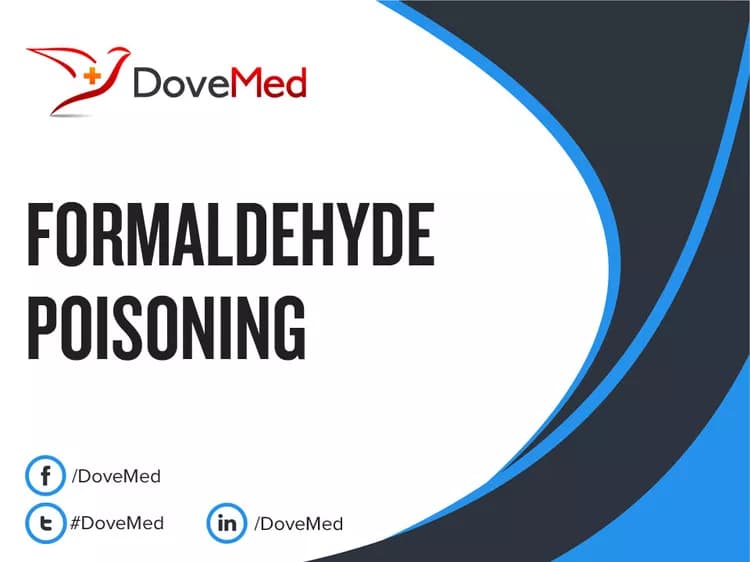What are the other Names for this Condition? (Also known as/Synonyms)
- Formaldehyde Exposure
- Formaldehyde Toxicity
- Formalin Toxicity
What is Formaldehyde Poisoning? (Definition/Background Information)
- Formaldehyde Poisoning is a condition that results from inhaling formaldehyde fumes. Formaldehyde is a colorless gas, with a strong suffocating odor. It is synthesized by the oxidation of methanol
- Routes of exposure of formaldehyde could be inhalation, absorption through the skin, and ingestion
- Formaldehyde-based products are used in the manufacture of glass mirrors, explosives, artificial silk, and dyes. It has also been used as a disinfectant and germicide
- The signs and symptoms associated with Formaldehyde Poisoning include nose, throat, or eye irritation, headache, skin rashes, fatigue, sleep interference, nausea, and difficulty breathing
- The first step in the treatment of Formaldehyde Poisoning is to stop further exposure by removing the individual from the area of exposure. This is followed by symptomatic treatment of poisoning depending upon the organs involved
- Most patients recover fully from inhalation at low-levels. Exposure to high concentrations of formaldehyde, especially in confined places, can prove to be fatal
Who gets Formaldehyde Poisoning? (Age and Sex Distribution)
- Any individual who has been exposed to formaldehyde may suffer from Formaldehyde Poisoning. Although, children are more vulnerable to toxins which are absorbed through the skin
- There is no distinct gender, racial, or ethnic predilection observed
What are the Risk Factors for Formaldehyde Poisoning? (Predisposing Factors)
The risk factors associated with Formaldehyde Poisoning include:
- Working frequently with materials and chemicals that contain formaldehyde
- Occupations that involve using formaldehyde and formaldehyde-containing resins that are used in the manufacture of glass mirrors, explosives, artificial silks, and dyes
It is important to note that having a risk factor does not mean that one will get the condition. A risk factor increases ones chances of getting a condition compared to an individual without the risk factors. Some risk factors are more important than others.
Also, not having a risk factor does not mean that an individual will not get the condition. It is always important to discuss the effect of risk factors with your healthcare provider.
What are the Causes of Formaldehyde Poisoning? (Etiology)
Working with formaldehyde or using equipment that has been cleaned with formaldehyde can cause Formaldehyde Poisoning.
What are the Signs and Symptoms of Formaldehyde Poisoning?
The signs and symptoms associated with Formaldehyde Poisoning include:
- Irritation of the nose, throat, or eyes
- Headaches, nausea
- Skin rashes
- Fatigue
- Sleep interference
- Breathing difficulties
How is Formaldehyde Poisoning Diagnosed?
There are no specific tests to evaluate Formaldehyde Poisoning; however, the diagnosis may involve:
- Complete evaluation of medical history and a thorough physical exam: This may also involve collecting information on any recent exposure to chemicals and substances
- Pulmonary function test - series of test that evaluate the lung function
- Chest x-rays
- Bronchoscopy: The use of a fiber-optic scope to visualize the main airways of lungs
- Arterial blood gases: To measure the levels of carbon dioxide and oxygen in blood, to determine the level of lung functioning
- Endoscopy: To examine the digestive tract without performing surgery
Many clinical conditions may have similar signs and symptoms. Your healthcare provider may perform additional tests to rule out other clinical conditions to arrive at a definitive diagnosis.
What are the possible Complications of Formaldehyde Poisoning?
The complications associated with Formaldehyde Poisoning may include:
- Asthma attacks when exposed to high concentrations of the chemical
- Long-term and chronic exposure has been linked to cancers of the nasal passages and sinuses
- Repeated exposure can cause bronchitis, pneumonia, and asthma
- Blindness
- Multi-organ failure
How is Formaldehyde Poisoning Treated?
The first step in the treatment of Formaldehyde Poisoning is in preventing further exposure to the substance. The symptoms are treated as they occur:
- Eyes and skin are flushed with water or saline immediately
- Antibiotic eye-drops can be given to prevent infection
- Oxygen, bronchodilators, inhalers, and intermittent positive pressure breathing (IPPB) can be used to treat respiratory distress
- Milk, water, or activated charcoal is given to deactivate formaldehyde, if it has been swallowed
How can Formaldehyde Poisoning be Prevented?
The prevention of Formaldehyde Poisoning may require the following measures:
- Use of “exterior-grade” pressed wood products
- Ask about formaldehyde content in wood products before purchasing them
- At homes:
- Ensure adequate ventilation
- Moderate temperatures
- Reduce humidity by using air-conditioners and humidifiers
- Testing formaldehyde at home by using a “home air check test”
What is the Prognosis of Formaldehyde Poisoning? (Outcomes/Resolutions)
- Formaldehyde inhalation at low-levels can usually be treated and most patients are able to completely recover from Formaldehyde Poisoning
- Exposure to high concentrations, particularly in confined places can prove to be fatal
- Overall with appropriate and prompt management, the prognosis of Formaldehyde Poisoning is good
Additional and Relevant Useful Information for Formaldehyde Poisoning:
Formaldehyde is found in as many as 3,000 building products making it one of the most common air pollutants.
Related Articles
Test Your Knowledge
Asked by users
Related Centers
Related Specialties
Related Physicians
Related Procedures
Related Resources
Join DoveHubs
and connect with fellow professionals


0 Comments
Please log in to post a comment.